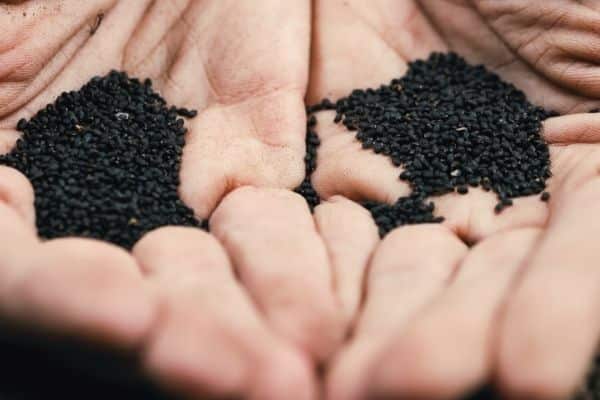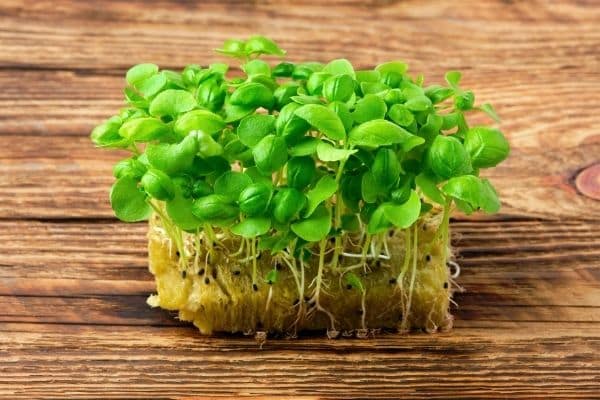Basil is a good herb to add to the dishes in your kitchen. You can add the basil in your soup, stew, spaghetti sauce, or tomato sauce. But you might not have fresh basil throughout the whole year if you have planted the annual varieties. So, you have to preserve the basil for the period when the fresh basil won’t be available. So how are you going to preserve it, right?
Can you freeze the fresh basil?
Yes, you definitely can freeze the fresh basil. As basil is sensitive to cold, you can’t directly put it in the fridge. Before freezing it, you have to process it well otherwise the leaves may turn black.
Well, the frozen basil may not taste as good as the fresh one. But you can easily use the frozen basil for cooking dishes except for garnishing. So, if you want to freeze the basil, there are many ways to freeze it as you can’t directly put it into the fridge.
So, let me tell you about the freezing methods so that you can use them to freeze the basil. Let’s dig in deeper!

Table of Contents
How to freeze basil in the fridge
There may be times when you get too many leaves from your plant. Or maybe the harvests are too much for you to use. Or else, you might want to preserve the basil for the winter. So, no matter what the reason is, all you want is to preserve the basil, right?
Basil is a delicate herb. That’s why keeping it fresh for a long time is quite difficult. But with a few techniques, you can preserve basil easily.
So when we talk about the techniques, we can say that freezing is probably the easiest way to preserve the basil. For this reason, I am sharing 3 easy ways to preserve basil in the fridge.
1. Freeze the whole leaves
Freezing the whole leaf is probably the easiest task when it comes to freezing. There is nothing much to do and you can use these frozen leaves later as a fresh one. In this way, you can have basil for the whole year round for adding in the soup or sauces.
For this technique, collect the basil from the stem. Wash them properly and leave them on a paper towel for drying. Now keep the boiling water and a bowl of ice water ready.
Put the basil leaves in the boiled water. Leave them in the pot of water for not more than 3 to 4 seconds. You just have to blanch the leaves and so these few seconds will work. Now using a slotted spoon take the leaves out of the hot water and place the basil in ice water. Leave that for a few seconds to let them cool down.
After a few seconds, get them out of the cold water and place them on a paper towel again. Once this is done, you can make layers of the leaves placing them separately on a parchment sheet. Put the leaves according to the paper size and place the sheets in a freezer-safe container box or plastic bag. Finally, put them in the freezer and get them out when it’s needed.
2. Freeze the basil as ice cubes
If you want to add basil flavor to the soup, then the easiest way is to add a basil cube to it. For making the ice cubes, you have to remove the leaves from the stem first. Then wash it properly and dry it using a paper towel.
Now use a food processor to grind the basil leaves. When the leaves are almost done, add some extra virgin olive oil to them. You can put 1 tablespoon of olive oil for 1 cup of basil. After adding the oil, make a fine paste of basil.
Then use a spoon to take the puree out of the food processor and place them in the ice cube tray. Freeze it for 8 hours or overnight and after that remove the cubes out of the tray to preserve it in a freezer bag or inside a container.
However, if you don’t want to make a puree, you can use one more technique to make basil cubes. You can chop the basil roughly. Then fill the cube tray with olive oil and put some chopped basil pieces into that oil using the edge of your knife. Then freeze it and later on preserve them in the container or freezer bags. You can use these cubes in your pasta dishes easily.
3. Turn your pesto into ice cubes
Now the final way to freeze your basil is to make pesto cubes. In this way, you can preserve the basil for up to 6 months or more than that.
You can make a basil pesto recipe as per your preference. Or else, you can add 2 cups of basil, 2 cloves of garlic, 1/2 cup Parmesan cheese, and 1/4 cup of almonds, pine nuts, and walnuts in the food processor to chop them finely. After that add 6 tablespoons of extra virgin olive oil or as much it is needed to make a paste. Grind it until it makes a fine paste.
Then remove the pesto out of the food processor and put it in the cube trays. Once they get frozen, replace the cubes in a freezer bag or container to preserve them. You can also add some other seasoning of your choice.
Other ways to preserve basil leaves other than freezing
Many people may not want to freeze the basil as they find it difficult to do or simply they don’t prefer the freezing ones. That’s why I am adding some more ways to preserve basil other than freezing.
So, here are 5 preserving ways to preserve the basil leaves without freezing them.
1. Make the powder of dry basil leaves
Though the dry basil leaves are not as tasty as the fresh ones, they can be added to your recipes in many ways. The easiest way to dry the basil is a microwave oven.
All you have to do is to remove the leaves from the stem and wash them properly. Then dry them using tissue or paper. After that, set the oven temperature at the lowest rate. Place the leaves on a cookie sheet and place them on a baking tray.
Leave the basil in the oven for 2 to 4 hours on the upper rack of the oven. And wait for it to become crumbly.
When you remove the tray out of the oven, keep it for a few moments to cool it down. Once they are cool enough to touch, crumble them with hands and store them in a container. Make sure you have preserved the powder in an airtight container.
2. Make basil flavored vinegar
By making basil-flavored vinegar, you can also preserve the basil. It is very easy to make basil-flavored vinegar.
First of all, remove the basil leaves from the stem and wash them properly. Using a salad spinner, you can dry the leaves. Now, take a mason jar and filled the jar up to 1/2 to 2/3 with basil leaves. Now fill the remaining part of the jar with white vinegar and seal the container properly.
Store the jar in a cool and dark spot for almost 2 weeks. After 2 weeks you can take the leaves out of the jar and replace the vinegar in a clean bottle. And with this, your vinegar is ready to put in your favorite recipes.
3. Make basil flavored vodka
Preserving basil with vodka may sound surprising to you but this is true. This way is too simple to carry on with your basil. Vodka has an amazing ability to keep the fresh basil flavor and aroma.
All you have to is, put one cup of fresh basil in a mason jar. Add 2 cups of vodka to it. Close the jar lid and leave it in a cool and dark place. Keep the jar in that place at least for 3 days to infuse.
You can taste it daily to check its potency level. But if you want, the lighter taste of the basil, then add one more cup of vodka to it. Once all the processes end, pull the leaves out and store them in the fridge.
4. Infuse basil using oil
This basil oil you can use for marinating, seasoning, or as the alternative to fresh herbs while cooking. For infusing oil with basil, you have to mix 4 cups of basil leaves with 2 cups of extra virgin olive oil in a food processor. Turn them into a fine paste and after that pour the mixture into a pan.
Heat the mixture for around 45 seconds at medium flame. Next strain the mixture using a mesh strainer. Let the mixture rest for a few hours and you will notice the little particles of basils resting down in the bowl. Finally, move the oil in a container from the upside leaving the particles of basil behind in the bowl.
5. Preservation method for a short period
The water method and towel method are some ways to keep your basil fresh for at least 7 days.
For the water method, you have to collect the stem of the basil, cut the end of the stem and simply put it into the jar or pot of water. Next, wrap the upper part of the leaves with a plastic bag and put it in a cold place or inside the refrigerator. In this way, you can preserve the basil with its fresh green leaves.
And if that is not that convenient, then put the individual leaf in a single or more layer on a paper towel and roll the towel to preserve it like other herbs.
Few last words for you
It is for sure that nothing can beat the taste of fresh herbs. But if the herb is not available, then you can only rely on the preserving one.
You can freeze the basil leaves using the appropriate method out of all these. On the other hand, if you don’t like freezing your herb, you can go for other methods like powdering dry basil or infusing it with liquid. So, select the appropriate method for preserving the basil leaves and use it in your dishes. Happy Gardening!











 If your worm compost bed is comparatively smaller in size, it is more vulnerable to freezing conditions. Due to the small surface area and volume, it can preserve less amount of heat that can be lost easily.
If your worm compost bed is comparatively smaller in size, it is more vulnerable to freezing conditions. Due to the small surface area and volume, it can preserve less amount of heat that can be lost easily.

















